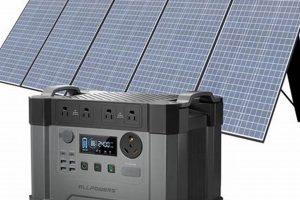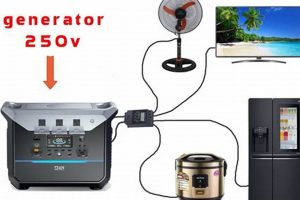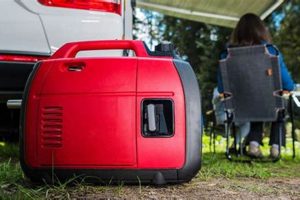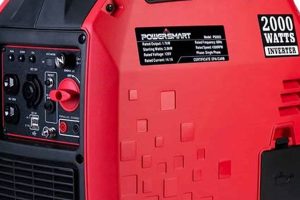Compact, fuel-powered electricity sources offer homeowners a backup power solution during outages caused by natural disasters or grid failures. These devices can power essential appliances, such as refrigerators, sump pumps, and lighting, maintaining a degree of normalcy and safety during disruptive events. A small unit might suffice for powering a few crucial items, while larger models can run most household systems.
Maintaining access to electricity is critical for modern life. Beyond convenience, power is essential for safety, communication, and the preservation of perishable goods and medications. Historically, homes lacked widespread access to consistent electrical power. The advent of these independent power sources provides a level of resilience and security unavailable to previous generations. This resilience is particularly valuable in areas prone to power disruptions.
Further exploration will cover key topics such as selecting the right unit size, understanding different fuel types, safe operation practices, essential maintenance, and exploring cost considerations.
Tips for Using Backup Power Systems
Safe and effective operation of backup power systems requires careful planning and adherence to recommended guidelines. The following tips offer valuable insights for homeowners considering or currently utilizing these devices.
Tip 1: Accurate Power Needs Assessment: Determine the wattage requirements of essential appliances. Summing these wattages provides the minimum generator capacity needed. Consider future appliance additions when calculating power needs.
Tip 2: Appropriate Generator Placement: Operate units outdoors in well-ventilated areas, away from windows and doors, to prevent carbon monoxide poisoning. Maintain a safe distance from flammable materials.
Tip 3: Safe Fuel Handling: Store fuel in approved containers in a cool, dry, and well-ventilated area. Never refuel a hot or running unit. Allow the unit to cool completely before refueling.
Tip 4: Regular Maintenance: Perform routine maintenance according to manufacturer recommendations. This includes oil changes, air filter cleaning, and spark plug replacement. Regular maintenance ensures reliable operation.
Tip 5: Professional Installation of Transfer Switches: A properly installed transfer switch isolates the generator’s power from utility lines, preventing backfeeding and protecting utility workers. Consult a qualified electrician for transfer switch installation.
Tip 6: Carbon Monoxide Detectors: Install carbon monoxide detectors in the home to provide early warning of potentially lethal carbon monoxide buildup. Test detectors regularly to ensure proper function.
Tip 7: Familiarization with Operating Procedures: Thoroughly review the manufacturer’s operating instructions before using the unit. Understand the startup, shutdown, and troubleshooting procedures.
Adhering to these guidelines ensures safe and efficient operation, maximizing the benefits of backup power during outages. Proper planning and maintenance are crucial for reliable performance and long-term functionality.
By understanding these critical aspects of backup power systems, homeowners can make informed decisions and ensure their safety and well-being during unforeseen power disruptions.
1. Power Output
Generator power output, measured in watts, is a critical factor determining its suitability for various applications. Understanding power requirements ensures the selected unit can handle the intended load during a power outage. Insufficient power can lead to overloaded circuits and potential damage to appliances or the generator itself.
- Starting Watts vs. Running Watts
Starting watts, significantly higher than running watts, are required to power appliances with electric motors, like refrigerators and air conditioners, upon startup. Running watts represent the continuous power needed to operate appliances after they’ve started. A generator must provide sufficient starting and running watts to prevent system overloads.
- Calculating Power Needs
Accurately calculating power requirements involves summing the running watts of all intended appliances. Adding a safety margin of 20-30% accounts for potential surges and future additions. Online wattage calculators can assist in this process, simplifying accurate load determination.
- Generator Size and Power Output
Generators are available in various sizes with varying power outputs. Smaller, more portable units typically offer lower wattage suitable for essential appliances. Larger units provide higher wattage capable of powering entire homes or multiple appliances concurrently. Size selection depends on individual power needs and budget constraints.
- Impact on Appliance Functionality
Matching generator power output to appliance requirements ensures proper functionality. Overloading a generator risks damaging appliances and the generator itself. Underpowering prevents essential appliances from operating during an outage, potentially jeopardizing safety and comfort.
Careful consideration of power output ensures selection of a generator capable of meeting household needs during power disruptions. Accurately assessing wattage requirements and understanding the distinction between starting and running watts are crucial steps in choosing the right generator, ensuring optimal performance and preventing potential damage.
2. Fuel Type
Fuel type significantly influences the practicality and long-term viability of a portable generator for home use. Each fuel option presents distinct advantages and disadvantages that homeowners must consider based on individual needs and circumstances. Fuel availability, storage requirements, cost, and environmental impact are key factors in fuel selection. Common fuel types include gasoline, propane, diesel, and natural gas.
Gasoline offers widespread availability and ease of acquisition. However, it has a limited shelf life and can deteriorate over time, potentially causing engine problems. Propane, stored in readily available tanks, offers a longer shelf life and cleaner combustion. Diesel provides high efficiency and longer run times but can be more expensive. Natural gas, while requiring a professional connection, eliminates refueling concerns, offering continuous operation as long as the utility supply remains uninterrupted.
For instance, during extended power outages, gasoline availability can become an issue due to high demand and supply chain disruptions. In contrast, a large propane tank can provide fuel for extended periods, ensuring uninterrupted power. The choice of fuel directly impacts generator maintenance requirements. Gasoline-powered units necessitate more frequent maintenance due to carburetor cleaning and fuel stabilizer usage. Propane and natural gas generators typically require less maintenance.
Ultimately, fuel type selection represents a crucial decision in acquiring a portable generator. Carefully evaluating the trade-offs between fuel types, considering factors like availability, cost, storage, and maintenance, leads to a more informed choice aligned with individual needs and circumstances. A well-informed decision ensures the chosen fuel type supports reliable operation and long-term usability of the generator.
3. Runtime
Runtime, a crucial factor in portable generator selection, signifies the duration a generator can operate continuously on a full tank of fuel. This duration directly impacts the generator’s practicality during extended power outages. Extended runtimes reduce the frequency of refueling, a significant advantage during emergencies when fuel availability might be limited or access restricted. Runtime depends on several factors including fuel tank capacity, engine efficiency, and load. Higher loads generally result in shorter runtimes due to increased fuel consumption.
Consider a scenario where a power outage lasts several days due to a severe storm. A generator with a short runtime, requiring frequent refueling, poses logistical challenges and potential safety risks, particularly in hazardous conditions. Conversely, a generator with a longer runtime provides greater peace of mind and operational flexibility, reducing the need for frequent refueling trips. For example, a generator with a 10-hour runtime at 50% load can power essential appliances overnight, minimizing disruption to daily routines. Understanding runtime characteristics allows for informed decisions regarding fuel management and overall preparedness.
Matching runtime requirements to anticipated outage durations ensures sufficient power availability during emergencies. Evaluating fuel tank capacity and considering load requirements allows for accurate runtime estimations. Prioritizing generators with longer runtimes and incorporating fuel storage strategies enhances preparedness and reduces reliance on frequent refueling during critical periods. This understanding empowers homeowners to select generators that best suit their specific needs, ensuring reliable power during unforeseen outages.
4. Noise Levels
Noise generated by portable generators constitutes a significant consideration, particularly in residential settings. These units produce varying sound levels, measured in decibels (dB), depending on their size, engine type, and load. Excessive noise can disrupt daily life, disturb neighbors, and even violate local noise ordinances. Understanding noise levels is crucial for maintaining amicable community relations and ensuring compliance with regulations.
A small, inverter-type generator operating at a low load might produce noise levels comparable to normal conversation (around 60 dB). However, larger, conventional generators, especially under heavy load, can reach levels exceeding 80 dB, equivalent to a busy street. Prolonged exposure to such noise levels can cause stress and hearing damage. Consider a scenario where a generator operating near a bedroom window during the night disrupts sleep patterns, leading to fatigue and irritability. Alternatively, a noisy generator might strain relationships with neighbors, particularly in densely populated areas.
Manufacturers often provide decibel ratings for their generators. Consumers should consider these ratings when selecting a unit. Furthermore, strategies for noise mitigation include placing the generator on a sound-dampening mat, constructing noise barriers, or utilizing quieter inverter-type generators. Recognizing the impact of generator noise on both personal well-being and neighborhood harmony allows for informed decision-making and proactive mitigation strategies, ensuring responsible generator usage within residential environments.
5. Safety Features
Safety features in portable generators are crucial for protecting users, connected appliances, and the surrounding environment. These features mitigate risks associated with generator operation, such as carbon monoxide poisoning, fire hazards, and electrical shocks. Overload protection, a critical safety feature, prevents damage to the generator and connected appliances by automatically shutting down the unit when the electrical load exceeds its capacity. This prevents overheating and potential fires. Low-oil shutdown safeguards the engine from damage by automatically stopping operation when oil levels drop below a critical threshold. This prevents engine seizure and extends the generator’s lifespan.
For instance, a generator without overload protection could overheat and catch fire if too many appliances are connected simultaneously. Similarly, operating a generator with low oil can damage the engine, leading to costly repairs or complete engine failure. Carbon monoxide (CO) detectors, another vital safety feature, alert users to the presence of this odorless, colorless, and lethal gas. CO poisoning can occur if generators are operated in enclosed or poorly ventilated spaces. Automatic CO shutoff features enhance safety by automatically shutting down the generator when unsafe CO levels are detected. Consider a scenario where a family uses a generator indoors during a power outage. A CO detector with an automatic shutoff could save their lives by preventing CO poisoning.
Understanding and utilizing these safety features is paramount for safe and responsible generator operation. Regularly inspecting and maintaining these features ensures their proper function, minimizing risks and promoting safe electricity generation during power outages. Neglecting safety precautions can lead to severe consequences, underscoring the importance of prioritizing safety in all aspects of generator use. Informed consumers prioritize generators with robust safety features, contributing to a safer environment for themselves and their communities.
6. Portability
Portability is a defining characteristic of these generators, directly influencing their usability and suitability for various applications. The ease with which a unit can be moved and stored impacts its practicality for homeowners. This characteristic encompasses factors such as weight, dimensions, and incorporated features like wheels and handles. Understanding the nuances of portability helps consumers select units aligned with their specific needs and physical capabilities.
- Weight and Dimensions
Weight significantly impacts maneuverability. Lighter units are easier to transport and position, while heavier units might require assistance or specialized equipment for movement. Compact dimensions facilitate storage in limited spaces, such as garages or sheds. Weight and size considerations are paramount for individuals with physical limitations or those lacking storage space. For example, a lightweight unit might be easily moved by a single person, whereas a heavier unit might require two people or a dolly.
- Wheels and Handles
Integrated wheels and handles simplify transport, reducing strain and effort. Ergonomically designed handles enhance grip and control during movement. These features are especially beneficial for traversing uneven terrain or navigating stairs. The presence of never-flat wheels, for example, ensures reliable mobility even over rough surfaces.
- Storage Considerations
Compact designs minimize storage footprint. Units with foldable handles or removable components further reduce storage space requirements. Consideration of storage space is essential for homeowners with limited storage capacity. A compact, foldable unit might easily fit in a small storage closet, whereas a larger, non-foldable unit might require dedicated floor space.
- Impact on Usage Scenarios
Portability influences the generator’s suitability for various applications. Highly portable units are ideal for recreational activities like camping or tailgating, while moderately portable units are better suited for home backup power during emergencies. A lightweight, compact unit might be easily transported in a vehicle for camping trips, while a larger wheeled unit might be more suitable for home backup power.
Careful evaluation of portability factors ensures selection of a unit that aligns with individual needs and physical capabilities. Balancing portability with power output and other essential features optimizes the generator’s usability, ensuring convenient transport, storage, and deployment in various scenarios. Prioritizing portability enhances the overall practicality and user experience, reinforcing its importance as a key consideration in generator selection.
7. Maintenance
Regular maintenance is essential for the reliable and safe operation of portable generators. Neglecting routine maintenance can lead to decreased performance, reduced lifespan, and increased risk of malfunctions, particularly during critical power outages. Maintenance procedures vary depending on the generator model and manufacturer recommendations, but some common tasks apply universally. These include regular oil changes, air filter cleaning or replacement, spark plug inspection and replacement, and fuel system maintenance. A well-maintained generator ensures consistent performance and extends its operational life, maximizing the return on investment.
For instance, neglecting oil changes can lead to engine damage due to increased friction and heat. A clogged air filter restricts airflow to the engine, reducing power output and increasing fuel consumption. Worn spark plugs can cause misfires, reducing efficiency and potentially damaging the engine. Fuel system maintenance, such as draining old fuel or adding fuel stabilizer, prevents carburetor clogging and ensures reliable starting. Consider a scenario where a homeowner relies on a generator during a severe winter storm. A neglected generator might fail to start or malfunction during the outage, leaving the homeowner without power during a critical time. Regular maintenance mitigates such risks.
Consistent maintenance practices contribute significantly to the longevity and dependability of portable generators. Adhering to manufacturer-recommended maintenance schedules and promptly addressing any identified issues ensures optimal performance and minimizes the risk of unexpected failures. This proactive approach to maintenance safeguards the investment and provides reliable backup power when needed most, underscoring the crucial link between regular maintenance and the consistent, safe operation of portable generators in residential settings.
Frequently Asked Questions
This section addresses common inquiries regarding portable generators for home use. Understanding these aspects contributes to informed decision-making and safe operation.
Question 1: How is the correct generator size determined for home use?
Generator size selection depends on the wattage requirements of the appliances intended for backup power. Calculating the sum of running watts for essential appliances and adding a safety margin provides an accurate estimate of required generator capacity.
Question 2: What are the primary fuel options for portable generators?
Common fuel options include gasoline, propane, diesel, and natural gas. Each fuel type presents distinct advantages and disadvantages regarding availability, storage, cost, and environmental impact. Selection depends on individual needs and circumstances.
Question 3: Where should a portable generator be placed during operation?
Generators should always be operated outdoors in well-ventilated areas, away from windows, doors, and flammable materials. This placement minimizes carbon monoxide poisoning risks and fire hazards.
Question 4: How frequently should generator maintenance be performed?
Adhering to manufacturer-recommended maintenance schedules is crucial for optimal performance and longevity. Regular maintenance tasks include oil changes, air filter cleaning or replacement, spark plug inspection, and fuel system maintenance.
Question 5: Are transfer switches necessary for safe generator operation?
Professional installation of a transfer switch is highly recommended for safe generator integration. Transfer switches isolate the generator’s power from utility lines, preventing backfeeding and protecting utility workers from electrical hazards.
Question 6: What safety precautions should be observed when operating a portable generator?
Essential safety precautions include operating the generator outdoors in a well-ventilated area, never refueling a hot unit, and installing carbon monoxide detectors in the home. Familiarization with manufacturer’s operating instructions is paramount for safe and effective use.
Careful consideration of these frequently asked questions promotes safe and effective generator usage, minimizing risks and ensuring reliable backup power during outages.
Further information regarding specific generator models and local regulations can typically be found on manufacturer websites and local government resources.
Portable Generators for the Home
Careful consideration of factors like power output, fuel type, runtime, noise levels, safety features, portability, and maintenance ensures selection of a unit appropriate for individual needs and circumstances. Understanding these aspects empowers consumers to make informed decisions, maximizing the benefits and minimizing the risks associated with backup power during outages. Investing in a suitable unit provides a crucial layer of resilience against unforeseen power disruptions, safeguarding essential household functions and enhancing overall safety and comfort.
Reliable access to electricity is paramount in modern life. Portable generators offer a practical solution for maintaining essential services during power outages. Thorough planning, careful selection, and diligent maintenance ensure these devices provide dependable backup power when needed most, offering peace of mind and enhanced preparedness for unforeseen disruptions. Prioritizing safety and responsible usage practices ensures these valuable tools contribute positively to household resilience and community well-being.






